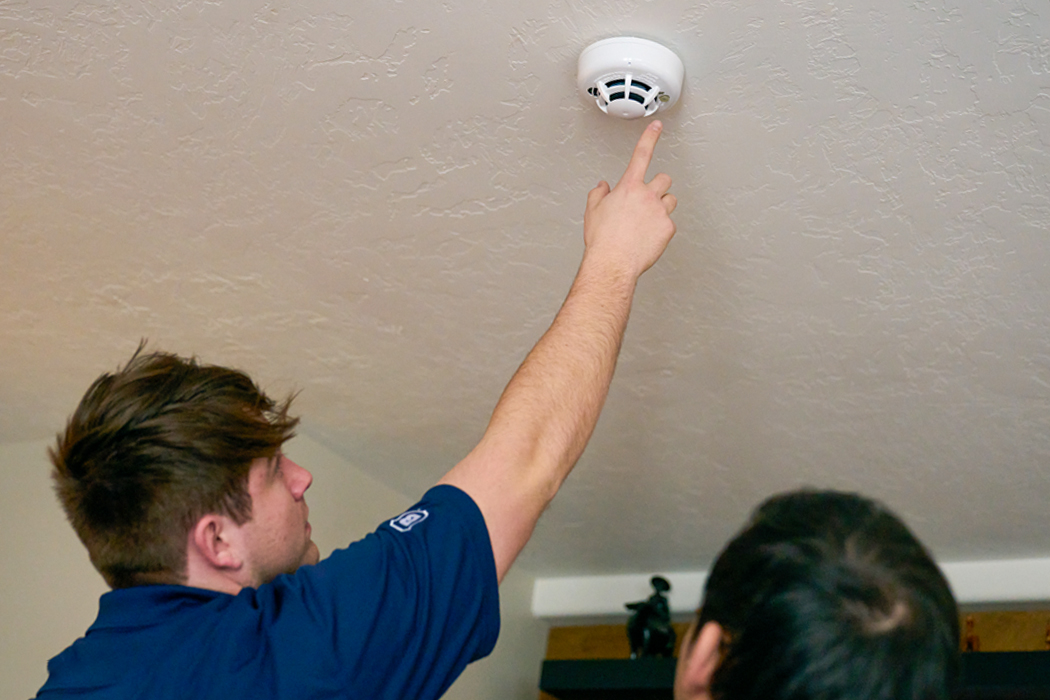Why is My Carbon Monoxide Detector Beeping?

Many people have carbon monoxide (CO) detectors in their homes to alert them of the presence of this potentially deadly gas. Carbon monoxide detectors, when triggered, set off an audible alarm in your home. While having a detector is essential, knowing what to do if your carbon monoxide alarm goes off is just as important.
According to a case study shared by the National Fire Protection Association, more than 600,000 carbon monoxide (CO) incidents involving poisoning or death were reported over the past decade. That’s an average of 7 incidents every hour. While these numbers are alarming, increased adoption of carbon monoxide detectors in homes and apartments has played a critical role in helping to save lives by alerting people to the presence of CO.
These statistics highlight the importance of having a carbon monoxide detector—and, ideally, a natural gas detector—in your home. Before we dive into what to do when your carbon monoxide alarm goes off, let’s first understand the characteristics of carbon monoxide and how detectors work to protect your family.
How Do Carbon Monoxide Detectors Work?
Carbon monoxide detectors monitor the air for dangerous levels of CO gas and emit a loud beep when these levels are detected. If you have your carbon monoxide detector connected to a home security monitoring service, such as Brinks Home™, it will also notify the Alarm Response Center and dispatch an emergency response. The three most common types of CO detectors are biomimetic sensors, metal oxide semiconductors, and electrochemical sensors.
Biomimetic Sensor
A biomimetic sensor uses a gel that changes color in the presence of carbon monoxide. When this change occurs, the detector senses the shift and sounds an alarm to alert your household.
Metal Oxide Semiconductor
These detectors contain a silica chip that responds to carbon monoxide by reducing electrical resistance. When this happens, the detector activates an audible alert.
Electrochemical Sensor
An electrochemical sensor uses electrodes in a chemical solution to alert when your home has high levels of CO. When the levels of carbon monoxide in your home are on the rise, the electrochemical sensor will lower the electrical current and will alarm your detector.
What to Do If a Carbon Monoxide Alarm Goes Off
If your carbon monoxide detector starts beeping, triggering an alarm in your home, it’s crucial to act immediately. Leave your home and do not assume it’s a false alarm or try to identify the source of the issue. Once outside, call your local fire department to have the home checked over to determine the reason for the alarm going off. Even if the alarm was triggered by something minor—like low batteries or a temporary power loss—you should never investigate until professionals confirm there’s no danger.
If someone in the home is displaying signs of illness, there could be carbon monoxide present. The symptoms associated with carbon monoxide exposure include weakness, dull headache, nausea or vomiting, shortness of breath, dizziness, confusion, loss of consciousness, and blurred vision. If any of these symptoms are displayed, it is best to move the person outside and call 911 for medical help. Always follow up by contacting the fire department to evaluate the home for any presence of carbon monoxide.
If your carbon monoxide detector starts beeping, do not ignore it. CO is a silent killer—it is odorless, tasteless, and invisible, making the alarm your best and often only warning.
Evacuate the Home Immediately: Leave your home right away. Do not attempt to locate the source of the carbon monoxide or assume it’s a false alarm.
Call 911 or Your Local Fire Department: Once outside and at a safe distance, contact emergency responders to report the alarm.
Seek Medical Attention If Necessary: If anyone in the home shows symptoms like those mentioned above, seek immediate medical help. These symptoms can vary in severity depending on exposure levels and time.
Do Not Re-Enter the Home: Stay outside until emergency personnel confirm that it’s safe to return.
Regular maintenance is key. Test your CO detectors monthly and replace batteries as needed. Annual inspections of all safety devices in your home help ensure they're functioning correctly.
How to Turn Off a Carbon Monoxide Alarm
After emergency responders have cleared your home and confirmed it's safe to re-enter, you can turn off the CO alarm.
Press the Reset or Silence Button: Most detectors have a clearly labeled button to stop the beeping.
Replace Batteries: If the beeping continues after resetting, try changing the batteries.
Check the User Manual: Some models may require a more specific reset process.
Consider Replacement: If your alarm is older or still beeping after troubleshooting, it may be time for a new unit.
Remember, you should never try to silence the alarm before evacuating and receiving an all-clear from professionals.
Add a Monitored CO Detector With Brinks Home
A standard carbon monoxide detector is an excellent safety device, but a professionally monitored CO detector provides even more protection. Brinks Home offers carbon monoxide detectors that are integrated into a smart home security system, giving your family advanced safety features.
When high levels of carbon monoxide are detected, the device sounds an alarm and immediately alerts our Five Diamond Alarm Response Center. This ensures that emergency services are dispatched quickly, even if you are asleep, away from home, or incapacitated.
Brinks Home also offers professional installation, so you can feel confident your system is set up correctly and operating as it should. With 24/7 monitoring, you get peace of mind knowing that your home and loved ones are protected around the clock.
Knowing what to do if your carbon monoxide alarm goes off can make all the difference in an emergency. Whether you already have carbon monoxide detectors installed or are looking to upgrade your home safety system, Brinks Home is here to help you take the next step in protecting your family from invisible threats like carbon monoxide. Contact us and get a free quote today.



